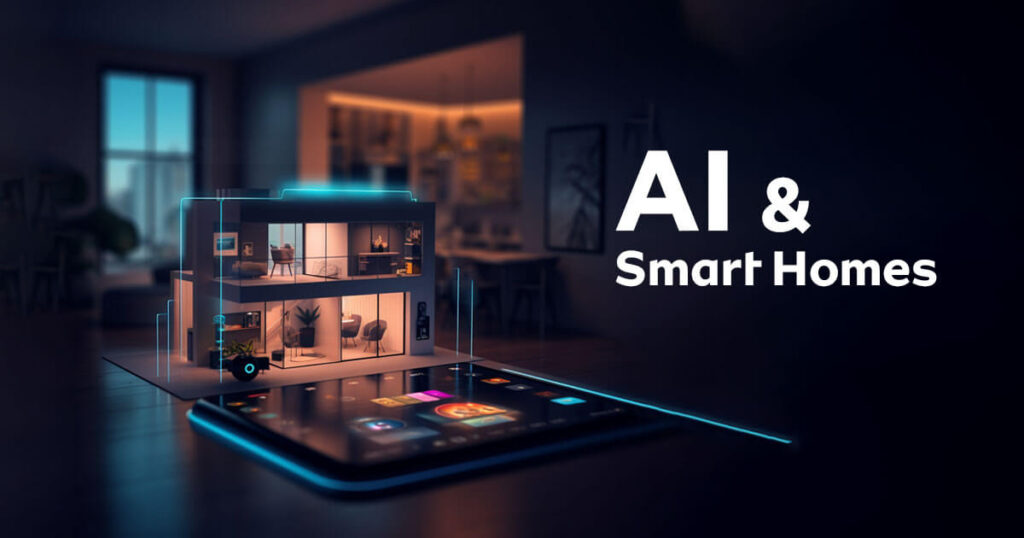Welcome to the future of living where your home knows your preferences, predicts your needs, and makes life easier with minimal input. This isn’t science fiction anymore. Thanks to advancements in artificial intelligence, AI in smart homes has evolved into a network of gadgets that think for you.
From thermostats that learn your comfort settings to lights that follow your routine, smart homes are becoming smarter, safer, and more efficient all powered by AI.
Introduction to AI in Smart Homes
Smart homes started with simple automation: timers, remote-controlled devices, and motion sensors. But now, AI is transforming these into intelligent systems capable of learning and adapting. AI in smart homes means devices not only respond—but also anticipate your behavior, optimize themselves, and communicate with each other seamlessly.
What Makes a Smart Gadget “Intelligent”?
Unlike traditional automation, AI-enabled gadgets:
- Learn from your habits over time (e.g., when you wake up or leave for work)
- Adapt settings based on your preferences and real-time conditions
- Make decisions proactively (like turning off unused appliances)
A smart light bulb may turn on with a clap. But an AI-powered light knows when you’re home, detects natural light levels, and adjusts brightness automatically.
Benefits of AI-Driven Smart Homes
- Convenience: Automate routine tasks like adjusting lights or locking doors.
- Energy Efficiency: Save power with learning thermostats and smart meters.
- Security: Monitor and secure your home with AI surveillance tools.
- Personalization: Customize every element of your living space—from music to lighting—based on your preferences.
Smart Assistants as the Brain of the Home
At the center of most smart homes are AI assistants:
- Google Assistant – Integrates with Android and Google services
- Amazon Alexa – Controls a vast ecosystem of devices
- Apple Siri/HomeKit – Focused on privacy and seamless Apple integration
These digital butlers answer questions, control gadgets, and even entertain. Just say, “Alexa, lock the doors,” and it’s done.
AI-Powered Security Gadgets
Your smart home is only as secure as its surveillance. AI now powers:
- Facial Recognition Doorbells (e.g., Nest Hello): Know who’s at the door—even when you’re away.
- Smart Locks (e.g., August, Yale): Keyless entry that adapts to your schedule.
- Motion-Detecting Cameras: Alert you only when something unusual happens.
Many systems can differentiate between people, animals, and moving cars—reducing false alarms dramatically.
Energy-Saving AI Gadgets
Cutting costs and saving the planet is now easier with:
- Smart Thermostats (e.g., Google Nest): Learn your preferences and weather patterns to adjust temperature.
- Automated Blinds & Lights: Adjust based on sunlight or occupancy.
- Smart Plugs with Energy Monitoring: Turn off idle devices and analyze usage trends.
These tools don’t just automate—they optimize your energy use.
AI in Kitchen and Appliances
Cooking meets computing:
- Smart Fridges: Track groceries, suggest recipes, and alert you to expiry dates.
- AI Ovens: Adjust temperature and cook time based on food type.
- Robotic Cooking Arms: Yes, some luxury smart kitchens now come with robot chefs that mimic human cooking motions.
Entertainment and Personalization with AI
Relaxation is smarter with:
- AI-Powered TVs: Recommend shows based on your tastes and even your mood.
- Voice-Controlled Speakers (e.g., Echo Studio, Google Nest Audio): Play music, manage calls, or read you the news.
- Multi-Room Audio: Syncs music across rooms, adjusting volume based on presence.
Entertainment becomes seamless and intuitive.
Health and Wellness in AI Smart Homes
- Sleep Trackers (e.g., Withings Sleep, Google Nest Hub): Monitor your sleep and adjust your environment.
- AI Air Purifiers: Detect pollutants and adjust airflow automatically.
- Smart Fitness Mirrors (e.g., Mirror, Tonal): AI-powered home gyms with real-time coaching and feedback.
Cleaning Robots That Learn Your Home
The classic smart vacuum just got smarter:
- Robot Vacuums (e.g., iRobot Roomba, Roborock): Map your home, remember furniture layout, and schedule cleanings.
- Mopping Bots: Handle tile, wood, and carpet differently.
- Self-Emptying Systems: Make cleaning truly hands-free.
These devices adapt to your floor plan and routines.
AI-Controlled Lighting Systems
Lighting impacts mood, energy, and sleep. AI-enhanced lighting systems:
- Mimic Natural Light Cycles: Align with your circadian rhythm.
- Use Presence Detection: Turn on only when someone’s in the room.
- Respond to Voice and Gesture: Control lights hands-free.
Smart Home Ecosystems and Integration
What makes a smart home truly smart is how well devices work together:
- Central Hubs (e.g., SmartThings, Home Assistant): Bring multiple brands under one roof.
- Mobile Apps: Control everything from a single dashboard.
- IFTTT and Routines: Automate complex tasks like “When I say ‘Goodnight,’ turn off lights, lock doors, and play white noise.”
Real-Life Case Studies: Smarter Living in Action
- Family of Four: Uses AI to automate chores, monitor kids’ rooms, and reduce bills.
- Elderly Couples: Gain independence and safety through voice commands and fall detection.
- Tech Professionals: Use AI dashboards to control everything from a smartwatch or remote office.
Challenges and Concerns of AI in Smart Homes
Every great advancement comes with caution:
- Data Privacy: Smart devices collect usage and voice data.
- Hacking Risks: Always use secure networks and two-factor authentication.
- Over-dependence: Relying too much on automation can reduce manual awareness.
Transparency and secure systems are key.
Future of AI in Home Automation
The future is smarter and more human-aware:
- Emotion-Aware Homes: Lights, music, and temperature adjust to your mood.
- Predictive Maintenance: Appliances notify you before they break down.
- Ambient Interfaces: Homes that respond to gestures, presence, and tone without saying a word.
Conclusion
AI in smart homes isn’t about the future—it’s happening now. From cooking and cleaning to lighting and security, gadgets that think for you are enhancing comfort, safety, and lifestyle quality like never before.
By blending automation with intelligence, your home can become a truly personal, helpful space. Start with one gadget—and soon, your entire living experience could transform.


